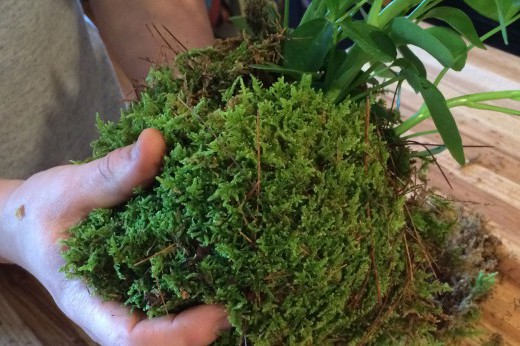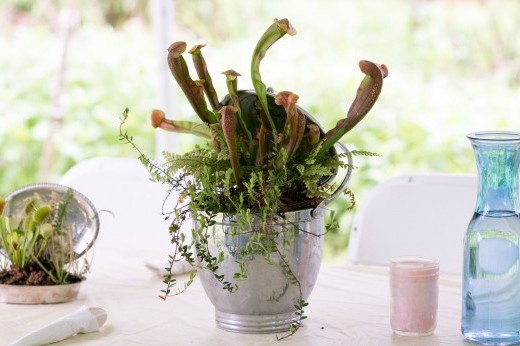Floating flower arrangements provide a limitless opportunity for creative expression. Inspired by nature itself—think lily pads suspended on the water’s surface and lotus flowers emerging from dark pond waters—floating flower arrangements use water as a backdrop, rather than a standing vase. Water allows you to play with color, texture, movement, light, and reflection.
These creative displays can be small enough to fit on a kitchen counter or table, or large enough for a garden or backyard statement piece. And they can be made in any season. No matter what size or style you choose, floating flower arrangements provide interest, beauty, and an element of surprise for those who happen upon them.
SUPPLIES
Choose a vessel
A wide bowl works well; the larger the bowl, the more space you will have to design. Pick the vessel based on where you want to place it. If it is going on a table, opt for a low bowl that won’t block anyone’s view. Feel free to use something unconventional, like a large hollowed-out stone or tree stump you can keep outside. Just be sure it is leakproof, or has been waterproofed with a liquid rubber sealant spray. You might not even need to look further than your kitchen—a circular takeout container or salad bowl can also make great vessels. A bowl with a dark bottom allows for better reflection.
Choose your plant material
These can be collected from your own garden, or you can buy bunches of flowers from your local supermarket or greenmarket. When you’re looking for flowers, consider ones with fused sepals (like daisies, mums, geraniums, or hibiscus). These will be the best floaters.
My plant material:
- Gazania ‘Kiss Orange Flame’
- Bidens (Spanish needles)
- Lantana (shrub verbena)
- Lonicera twig (honeysuckle)
- Geranium
You will also need a pair of scissors or garden shears and a floral bucket or jar to collect your plant material.
INSTRUCTIONS
Fill your vessel to the brim with clean water.
Cut the flowers very close to the knape of the bloom, leaving only a centimeter or less of stem. Then place them in the water to make sure they float and water doesn’t just fill the petal cup and sink the bloom.
You can begin your design in any multitude of ways. I started with the gazania ‘Kiss Orange Flame’ simply because the striping and colors are so striking. Then I added the bright pink lantana flowers and the burnt-orange bidens.
Use twigs or foliage to create structure. This will help your arrangement stay in place and prevent your design from floating apart. I’ve used a lonicera twig and placed flowers in between its branches. The bidens floating around the lonicera will float freely but are contained in little sections. This will help keep all the flowers from colliding together on one side of the bowl in case of wind.
Work with reflection. If you keep your arrangement simple and leave negative space, you’ll be able to see the reflection of the flowers themselves, and maybe even the sky or trees above. The rubber sealant I used also darkened the bowl, which creates a clean, reflective look.
To complete my design, I added some lighter pink tones in the form of geranium flowers, and a few more hot pink lantana inflorescences.
PLAYING WITH LIGHT AND SHAPE
Pictured below is an arrangement with a much simpler palette. The hellebores and daffodils are “doubled” by their reflections, and the sunken citrus branches can be seen both below and above the waterline.
Remember, some plants look different when they are submerged. The first time I put smoke bush foliage under water, it turned silver right before my eyes (this is a must try!). There are lots of leaves and flowers that you can spotlight by keeping them submerged or semi-submerged. To do this, you can use natural materials to weigh down branches, or you can use string and stones or even other flowers. Whenever possible, I prefer to use all natural materials so that your eye isn’t caught on the mechanics of the arrangement.
Pictured below is another arrangement in which I sunk two overlapping palm fronds to echo the floating cyparis leaves, which are shaped differently but have a similar linear texture. This gives the design a sense of depth.
Floating flower arrangements are a fun, simple way to use whatever plant material is available to create something truly special. With limitless color and plant combinations at your fingertips, this is a great way to flex your creativity and learn more about what’s in bloom near you.











